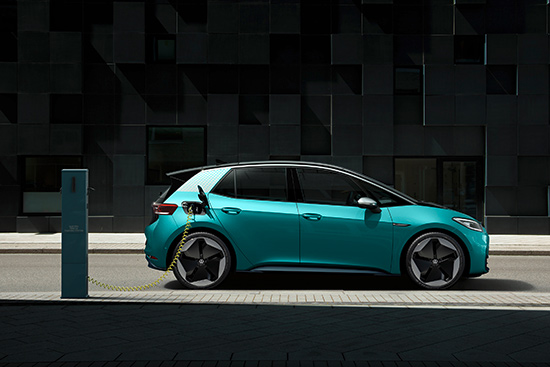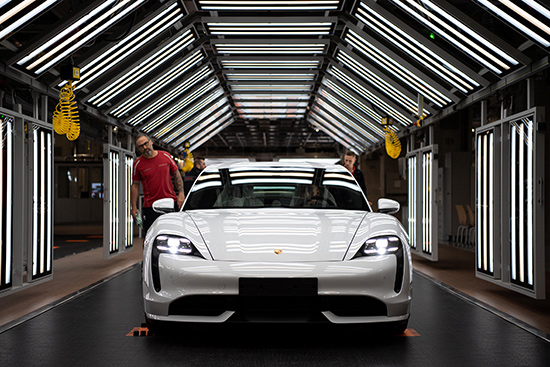電動汽車平價難實現,消費者不買賬

|
大眾集團正在進軍電動汽車市場,不過它采取了截然不同的兩個路線。 今年9月,大眾旗下的保時捷終于推出了大家盼望已久的Taycan轎車,它也是大眾集團在高端電動汽車市場的試水之作。Taycan的命名依然有著濃濃的保時捷的味道(Taycan這個單詞來自于土耳其語,意思是“一匹年輕駿馬的靈魂”),它有超強的快充能力,續航可達200英里以上,同時搭載了大量高新技術和控制元件,其起價超過了15萬美元。與此同時,在德國的法蘭克福車展上,大眾集團又推出了一款名為ID.3的小型掀背車,它的續航里程為341英里,外觀看起來跟一臺普通的大眾高爾夫大同小異,只是使用了頗顯洋氣的雙色配色,以彰顯它的異國情調和未來感。可惜的是,該配置的ID.3可能并不會登陸美國市場。 ID.3的賣點,就在于它是一款非常實惠的買菜車。它的售價還算比較親民(起售價約為3.3萬美元),而且配了一塊足夠的大的電池,基本能夠緩解車主的“里程焦慮癥”。雖然高端電動汽車市場已經是一塊穩穩當當的大蛋糕了——這點我們從特斯拉的崛起,以及保時捷Taycan的火爆預訂就能看出來(目前已經有3萬多人交了訂金)。但是對于我們這些普通人呢?路面上的這些平價汽油車啥時候才能換成電動汽車?我們的那些跨界SUV、那些作為“油老虎”的皮卡,以及我們孩子的第一輛車,什么時候才能變成電動的? |
The Volkswagen Group is getting charged up, and doing so in two vastly different ways. In September, the car conglomerate’s prized Porsche showed off the long-awaited Taycan, its entry into the luxury electric vehicle (EV) space. Taycan has a properly Porsche name (it translates from Turkish origin as “the soul of a spirited young horse”), ultra-fast charging capability, 200-plus miles of range, and a slew of fancy tech features and controls in the cabin. It also starts at a price north of $150,000. Meanwhile, at Germany’s own Frankfurt Auto Show, Volkswagen debuted the ID.3, a little hatchback promising 341 miles of range. The car, which sadly won’t be coming to America in this configuration, looks a bit like a typical Volkswagen Golf, albeit with a jazzy teal two-tone paint job to mark it as exotic and futuristic. The big deal about the ID.3 is its very ordinariness—and its attempt at an ordinary price tag (starting at about $33,000 USD) combined with a big enough battery to ease range anxiety. We know the luxury EV market is here to stay, as the rise of Tesla and the long line of Porsche Taycan preorders (30,000 deposits so far) have proven it. But how far are we from having a fleet of perfectly plain EVs populating our roads—our standard soccer-dad crossovers, our prized pickups, and our kids’ first car? Where are the mundane, workaday EVs? |

|
閃亮登場 將時間倒回10年前,也就是電動汽車剛剛興起的時候,你會發現,當時倉促上陣的電動汽車在外觀和功能上還很不成熟。比如2010年的推出的第一代日產Leaf,看起來就像一顆圓滾滾的土豆——這是因為它的外型基本照抄了日產的入門級家轎騏達。這種設計顯然是有意為之,目的是為了分流豐田普銳斯的部分潛在買主。10年前的普銳斯大概是最火爆的新能源車型了。 特斯拉的出現改變了這一切。特斯拉讓電動汽車變成了“高端大氣上檔次”的玩意兒。2012年,特斯拉的Model S轎跑一經推出,立即讓零排放轎車的理念深入人心。特斯拉的橫空出世起了一石二鳥的作用。它不僅成功地將電動汽車包裝成了一種高端產品,而不只是環保玩家自嗨的小眾車型,同時也掩蓋了在汽車里安裝鋰電池組的高昂成本。 隨著特斯拉的成功,在電動汽車市場的高低兩端,各大廠商仍在持續發力。捷豹公司推出了全電動轎跑i-Pace,奧迪和保時捷也跟風推出了e-Tron和Taycan等高端車型,試圖從特斯拉的Model S手中分一杯羹。與此同時,低端市場的競爭也愈發激烈。雖然雪佛蘭Bolt和寶馬i3銷量平平,但這并未阻止各大廠商紛紛進軍平價電動汽車市場的步伐。 目前,美國汽車市場即將進入汽車電動化的第三階段:全面電動化。全球多數汽車廠商都相繼宣布,要在本世紀20年代實現汽車產品的電動化,通過推出各種混合動力或全電動車型,滿足日益苛刻的環保要求。目前,各家電動皮卡已經紛紛入市,其中不僅有特斯拉和Rivian等初創公司的產品,也有很多來自于老牌汽車企業的產品。與此同時,各大車企也在紛紛研發大大小小的跨界車型、面包車和家用轎車。過不了多久,所有主流車型都會推出混動或純電版。要不了幾年,我們就能看見純電版的福特野馬跑車和F-150皮卡了。 不過,為什么很多人覺得自己對電動汽車的需求并不迫切?我們可以從銷售數據中找一下答案。 “平價”電動汽車并不平價 加州是美國最大的汽車銷售市場,也是美國最大的電動汽車銷售市場。2019年上半年,加州的電動汽車銷量較上年同期增長了63%,達到51750輛。不過這種增長主要是備受期待的特斯拉Model 3貢獻的。今年上半年,特斯拉Model 3的銷量達到了33000輛,相比之下,雪佛蘭Bolt和日產Leaf的銷量分別只有4482和2034輛。換句話說,雖說大家都覺得電動汽車的大趨勢不可避免,可真到用銀子投票的時候,多數人并不鐘情于傳統廠商推出的這些樸實無華的車型。 更流暢的設計、更堅實的充電設施和更好的技術性能,無疑助推了特斯拉的強勁銷量。對Model 3的一路唱衰也并沒有影響它的銷路。跟往常一樣,最大的影響因素還是價格。 雖然埃隆·馬斯克曾經信誓旦旦地宣稱,Model 3的售價大約在3.5萬美元左右,是一臺針對平民百姓的“買菜車”。不過一旦算上稅費,它的落地價還是飆過了4萬美元。(與此同時,特斯拉的聯邦稅收抵免已經下降到1875美元,而且很快就會完全取消。)當然,這個問題對于特斯拉的競爭對手也是存在的。雪佛蘭Bolt的售價在3.6萬美元以上。日產的第二代Leaf雖然比第一代有了明顯的改進,續航里程也達到了220英里,但它的售價也漲到了3萬多美元。作為兩款熱門小型跨界車的純電版,起亞Niro和現代Kona也面臨著同樣的問題, 現代就是一個很好的例子。Kona的汽油版是一款很受歡迎的小車,它的汽油版和純電版一同獲得了2019年度北美年度風云車大獎。Kona電動車的續航里程達到258英里,甚至超過了240英里的特斯拉Model 3。《人車志》雜志也因此稱Kona是市面上最好的純電車之一。在Kona純電版發布時,我個人曾以為,它標志著備受美國人喜愛的跨界車終于迎來了電動化時代。不過Kona雖然在一些海外市場獲得了成功,但它只在美國沿海的少數幾個州有售。截止到2019年7月,它在美國的銷量有1751輛。 [注:為了方便橫向比較,我省略了大眾高爾夫電動版和菲亞特500電動版等車型,因為這兩款車的續航里程非常有限,因而實用性堪憂。出于同樣原因,本文將不深入探討插電式混動汽車——也就是充電后只能在純電狀態跑個幾十公里,就要讓汽油發動機介入的汽車。今年上半年,插電式混動車型在美國賣得并不好,很大程度上是由于通用汽車停產了該領域的標桿車型——雪佛蘭Volt。] Kona電動版的最大敵人,或許就是Kona的汽油版。后者的經銷商建議零售價只有2.01萬美元,才剛過純電版的一半。即使買主可以拿到一筆豐厚的聯邦稅收抵免,再加上購電時各州或各市給予的退稅,也無法彌補這么大的差額。與此同時,美國的汽油價格近來一直保持疲軟,司機們也就更加沒有購買電動汽車的動力了。 大眾集團公布的ID.3的售價約在3.3萬美元左右,這是一個正確的方向,但大眾和其他傳統廠商一樣,也面臨著一個同樣的問題——除非電池的價格下降了,使得純電版汽車真的在價格上與汽油版有一拼,否則精打細算的美國消費者還是不會選擇電動汽車的。(財富中文網) 譯者:樸成奎 ? |
A Flashy Start Rewind a decade, back to the dawn of our current electric car resurgence, and you’ll see the hasty evolution in how EVs are supposed to look and what they’re allowed to be. The first Nissan Leaf, released in 2010, resembled a bulbous rolling potato. Its signature look stemmed in part from the fact that Nissan based the car on the entry-level Versa. Part of the science-project aesthetic was clearly intentional, though, meant to appeal to the same kind of early adopters who swarmed to the pod-like Toyota Prius during the previous decade, when it was the driving darling of the green set. That paradigm changed with Tesla. Elon Musk and company made electric driving sexy and attractive, stamping the brand’s vision of a zero-emissions luxury car onto our collective consciousness with the 2012 rollout of the Model S. Tesla pulled a double trick here. Reinventing the electric car as a premium product positioned it for success beyond just eco-focused buyers and helped to mask the steep cost of putting a big lithium-ion battery in a car. Both of those market trends continue. Jaguar built the all-electric i-Pace, which, along with the likes of the Audi e-Tron and the Taycan, competes with the Tesla Model S in the high-end electric market. And the more affordable future-pods roll on, with the Chevy Bolt and BMW i3 finding modest sales in electric-friendly markets. Now, though, the U.S. auto market stands at the start of a third phase of electrified driving: EV everything. Most of the world’s major auto companies have pledged to electrify their lineups during the 2020s, selling a wide variety of hybrids and totally electric vehicles to meet increasingly stringent fuel economy targets. Electric pickup trucks are coming, not only from flashy startups like Tesla and Rivian but also from established automakers. So are big crossovers, small crossovers, vans and cars. It won’t be long before every major car model offers a hybrid or all-electric version; EV Ford Mustangs and F-150 full-size trucks are a few years away. So why does it feel like adoption of everyday EVs isn’t exactly imminent? Take a quick look at sales numbers. An Affordable EV Is Not Necessarily An Affordable Vehicle In California, the nation’s largest auto market and biggest EV market by far, electric vehicle sales rose by more than 63 percent to 51,750 EV sales in the first half of 2019. However, the strength of the much-anticipated Tesla Model 3 drove that rise. Tesla sold 33,000 Model 3s against just 4,482 Chevy Bolts and 2,034 for the Nissan Leaf. In other words: the less-flashy electric offerings from traditional automakers aren’t drumming up the sort of EVmania we’ve been lead to believe is inevitable. A sleeker design, more robust charging infrastructure, and better tech features certainly aided Tesla’s strong sales. The steady drumbeat of Model 3 hype didn’t hurt, either. As usual, though, the prime culprit comes down to price. While Elon Musk ballyhooed the Model 3 as Tesla’s $35,000 everyman EV, it’s not exactly priced for the masses. Add on any options plus the new car fees and taxes, and the cost of even the base model can slip well over $40,000. (Meanwhile, Tesla’s federal tax credit is now down to $1,875, soon to disappear entirely.) And the competition isn’t doing much better. The Chevy Bolt starts north of $36,000. Nissan’s second-generation Leaf is a marked improvement over the original, but equipped with a 220-mile battery it also reaches the high $30,000s. The same is true of the Kia Niro and Hyundai Kona, fully electrified versions of popular small crossovers. The Hyundai is a telling case study. The Kona EV is derived from the brand’s popular gasoline-powered car, and together the two versions won the 2019 North American Utility of the Year award. Publications like Car and Driver lauded the Kona EV as one of the best fully electric options on the market, with its 258-mile range outpacing the 240 miles of the Tesla Model 3. Upon the EV’s release, I personally heralded it as a sign of things to come, when electric powertrains finally will enter the anonymous crossovers that Americans just can’t stop buying. But Hyundai, despite some success in friendlier overseas markets, is selling the Kona EV in just a select few coastal states and had moved a paltry 1751 units in the U.S. through July 2019. [Note: For the sake of apples-to-apples comparison, I’m omitting EVs like the Volkswagen e-Golf and Fiat e500, whose limited range make them impractical and primary autos. For the same reason, this article doesn’t dive into plug-in hybrid vehicles—those that allow drivers to plug into a charger and travel a few dozen miles on electric power before a backup gas engine kicks on. PHEVs cratered in the first half of 2019, largely because GM discontinued the field’s standard-bearer, the Chevrolet Volt.] The Kona EV’s killer might just be the Kona. Hyundai’s gasoline version starts with an MSRP of $20,100, barely more than half the cost of its electric cousin. Even a buyer who can snag a fat federal tax credit plus a state or local rebate for buying electric can’t make up that kind of gap. Meanwhile, with gas prices more or less stagnant across America, drivers have one less incentive to buy a ride that doesn’t rely on the pump. Volkswagen’s announced price for the ID.3 comes in at an estimated $33,000. That’s a step in the right direction, but VW stares down the same problem hanging over all the established car companies: Until batteries come down in price, at least enough that electric offerings become truly competitive with their internal combustion counterparts, budget-conscious Americans aren’t shifting into the EV lane. |













